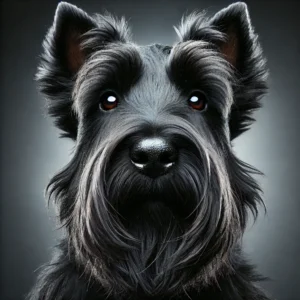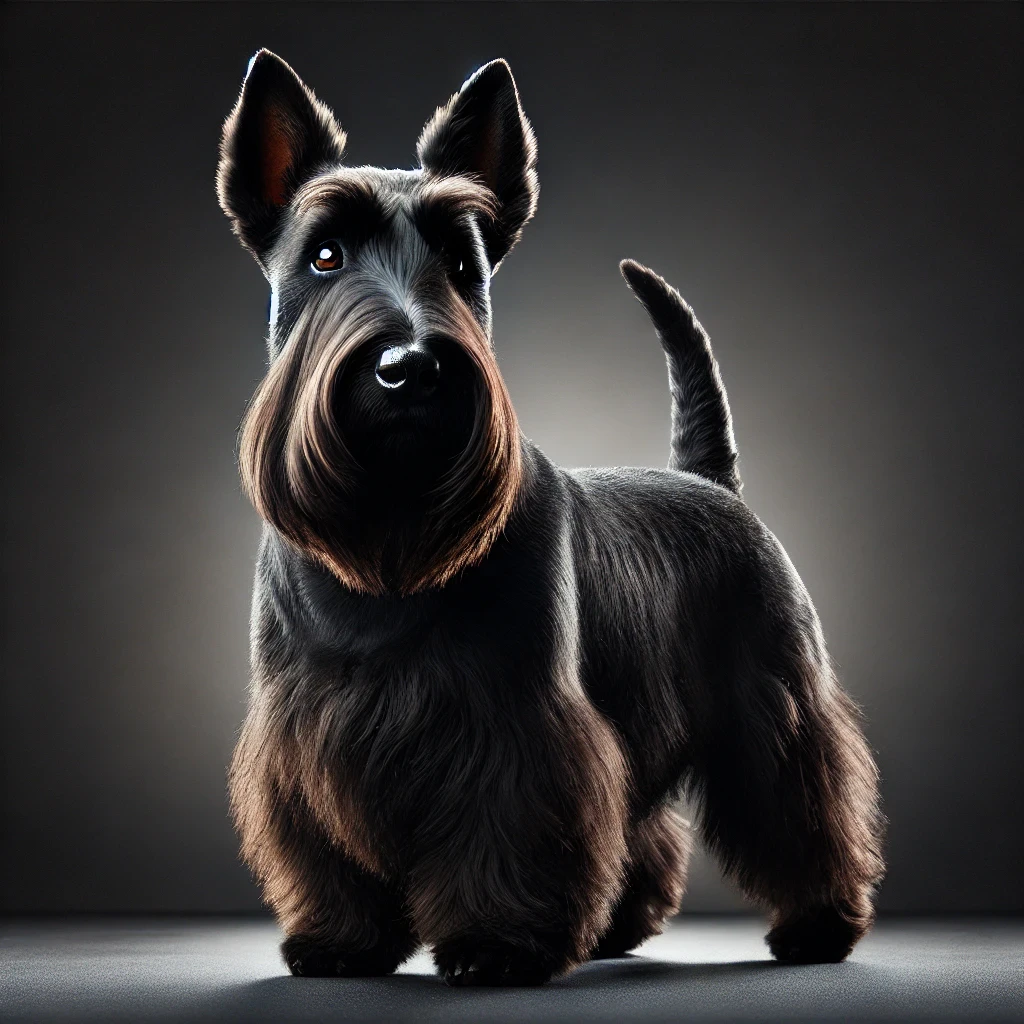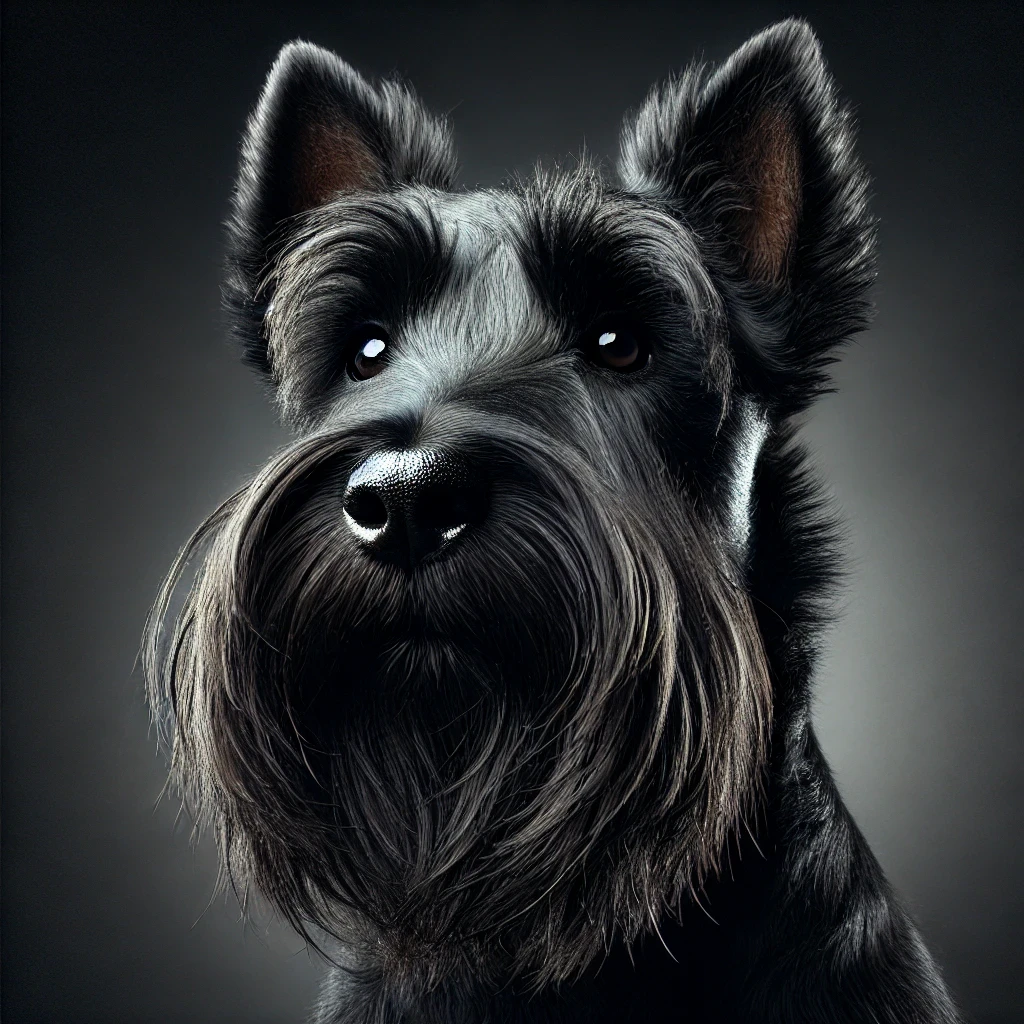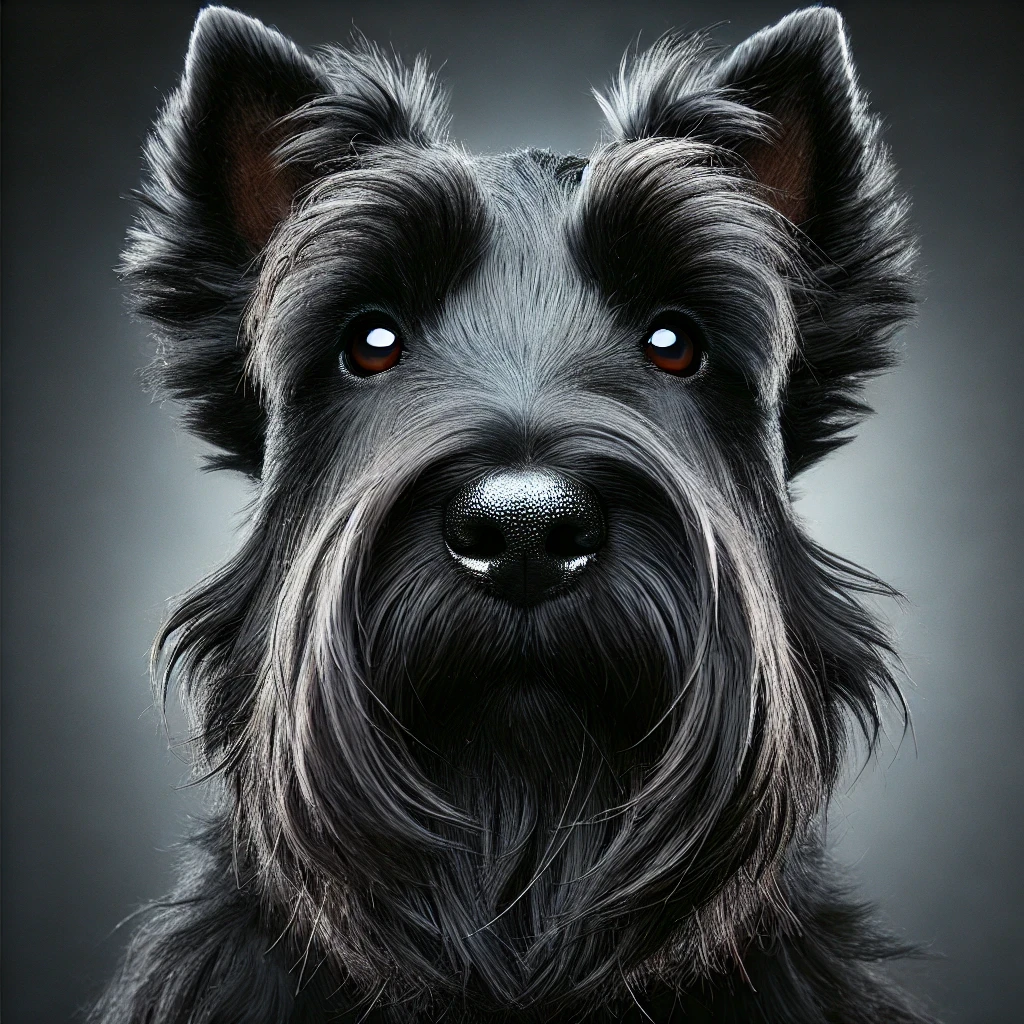In this guide, we’ll explore key Scottish Terrier dog breed facts including their origin, physical characteristics, temperament, health considerations, and why this breed continues to charm dog lovers everywhere.

The Scottish Terrier, affectionately known as the “Scottie”, is a small but fiercely independent breed with a big personality and a rich history. Originally bred to hunt vermin in the rugged Scottish Highlands, this iconic dog has earned admiration worldwide for its confident demeanor, distinctive appearance, and deep loyalty.
A Brief History of the Scottish Terrier
The Scottish Terrier is one of the most iconic and enduring dog breeds to emerge from the British Isles. With a lineage that stretches back to at least the early 18th century—and possibly even earlier—the Scottie is deeply rooted in Scottish history and tradition. Originally bred in the rugged Highlands, these hardy little dogs were developed as earth-working terriers, meaning they were specially trained and physically suited to dig into burrows and hunt down prey like foxes, rats, badgers, and other vermin that threatened farms and livestock.
These early terriers were highly valued by farmers and landowners for their bravery, efficiency, and persistence underground. Their compact, muscular build, strong jaw, and short legs allowed them to navigate tight tunnels, while their wiry double coat provided insulation against Scotland’s wet, windy climate. The breed was known for its courage and tenacity—so much so that they earned the nickname “The Diehard”, a term still used today to describe their relentless spirit.
The breed’s formal history began to crystallize in the late 1800s, when dog shows and breed registries became more popular in the UK. At the time, several small terriers from the Scottish region—including the ancestors of what would later become the Cairn Terrier, West Highland White Terrier, and Dandie Dinmont Terrier—were collectively referred to as “Skye Terriers” or simply “Scotch Terriers.” However, as breed clubs began to differentiate and standardize these types, the Scottish Terrier as we know it today began to take shape.
In 1879, the first official Scottish Terrier was shown in England, and shortly after, the breed standard was written. By 1881, the Scottish Terrier Club of England was founded, followed by the formation of the Scottish Terrier Club of Scotland in 1888. These developments helped firmly establish the breed’s distinct identity in the canine world.
Scottish Terriers quickly gained popularity beyond Britain. In the United States, their dignified appearance and confident personality resonated strongly with dog lovers. The breed was officially recognized by the American Kennel Club (AKC) in 1885, and it wasn’t long before Scotties became cultural icons in their own right.
Their reputation for loyalty and strength was further solidified through their connection to several American Presidents. Franklin D. Roosevelt’s beloved Scottie, “Fala,” became one of the most famous presidential pets in history. Fala was rarely out of sight from Roosevelt and even accompanied him to key wartime events and speeches. Today, a bronze statue of Fala sits alongside FDR at the Franklin Delano Roosevelt Memorial in Washington, D.C., the only presidential pet to receive such an honor. Later, President George W. Bush also kept two Scotties—Barney and Miss Beazley—at the White House, helping to maintain the breed’s public profile into the 21st century.
Beyond their political fame, Scottish Terriers also became staples of pop culture and branding. They were featured in advertising campaigns, collectibles, and films. Many will recognize the classic black Scottie figurine from Monopoly, where it remains one of the original game tokens.
Despite shifts in breed popularity over the years, the Scottie has remained a cherished symbol of tenacity, elegance, and independence. Their bold stance, serious expression, and no-nonsense attitude have made them enduring favorites among terrier enthusiasts and dog lovers around the world.

Explore Poogle Dog Breed Facts
Distinctive Appearance
One of the most recognizable Scottish Terrier breed facts is their unmistakable silhouette and signature features:
- Size: Compact and sturdy, weighing 18–22 pounds
- Height: Around 10 inches tall at the shoulder
- Coat: Dense, wiry topcoat with a soft undercoat—commonly seen in black, brindle, or wheaten
- Head: Long, rectangular muzzle with bushy eyebrows and a signature beard
- Tail: Medium-length, typically carried upright
Their bold stance and dignified presence give Scotties a look that is both elegant and strong.
Learn How Veterinary PPC Helps Dog Owners
Temperament and Personality: Understanding Scottish Terrier Dog Breed Facts
When exploring Scottish Terrier dog breed facts, one standout trait is their bold and dignified personality. Though small in size, Scottish Terriers have a temperament that’s strong, independent, and full of character. These dogs aren’t just adorable companions—they carry a noble spirit rooted in their working heritage.
Scottish Terriers are deeply loyal and often form a powerful emotional bond with one specific member of the household. Once that connection is made, expect your Scottie to become a dedicated shadow, following their chosen person—always on their own terms. While not overly clingy, their loyalty is unwavering.
One of the most important Scottish Terrier dog breed facts is their independent mindset. Originally bred to hunt solo in rugged Scottish terrain, they developed the instinct to make fast decisions without human input. That independence still shines today. They are intelligent and capable, but may resist commands if they don’t see the point. Many owners lovingly describe Scotties as “little generals” with minds of their own.
Scottish Terriers are also naturally wary of strangers, making them excellent watchdogs. They’re observant, alert, and slow to warm up to unfamiliar people. While not aggressive, they won’t hesitate to sound the alarm with a sharp bark if something seems off.
Another core trait in the temperament of Scottish Terriers is their strong prey drive. Their instinct to chase is deeply ingrained, so homes with small pets like rabbits, hamsters, or birds may not be ideal—especially if not raised together. A secure yard and a leash on walks are must-haves for this energetic little hunter.
Despite their tough exterior, Scottish Terriers also enjoy quiet companionship. Unlike lap dogs that constantly demand attention, Scotties appreciate personal space. They’re content to rest near their owners, observing with stoic calm. This makes them excellent pets for those who want a low-maintenance but emotionally deep bond with their dog. every first-time dog owner, Scottish Terriers thrive with experienced, confident handlers who appreciate their strong will and quirky charm.
Read Pug Dog Breed Facts
Exercise Needs and Training: Key Scottish Terrier Dog Breed Facts
When it comes to Scottish Terrier dog breed facts, one of the most commonly misunderstood areas is their exercise and training needs. While they may appear as low-energy lap dogs, Scottish Terriers are in fact spirited and active, requiring regular physical and mental stimulation to stay balanced and healthy.
Despite their compact frame, Scotties benefit from at least 30 to 60 minutes of daily activity. This can include:
- Daily walks: A brisk morning and evening walk will help burn off energy and reduce boredom-related behaviors.
- Backyard play: A securely fenced yard allows Scotties to safely indulge their natural urge to run and explore.
- Leash control: Due to their strong prey drive, it’s essential to keep Scottish Terriers on-leash in open or unfamiliar areas. These terriers will instinctively chase squirrels, birds, or even blowing leaves.
- Mental challenges: As independent and intelligent thinkers, Scotties thrive on brain games. Incorporate puzzle toys, hide-and-seek scent games, and short training sessions to stimulate their minds.
Training Tips for the Scottish Terrier
Among the more nuanced Scottish Terrier dog breed facts is that they can be stubborn and headstrong, making training a unique experience. They’re not defiant out of malice—they just like to do things their own way.
- Positive reinforcement works best: Use treats, praise, and play as rewards for good behavior.
- Short, varied sessions: Scotties get bored easily. Training should be firm but never harsh, and kept engaging.
- Early socialization is key: Introduce them to people, other dogs, and various environments while young to prevent over-guarding tendencies.
- Housebreaking may take patience: Like many terriers, they may take time to fully master potty training. Consistency is crucial.
Overall, training a Scottish Terrier is best suited for owners who are calm, consistent, and appreciate a dog with a mind of its own. The reward is a deeply bonded, well-behaved companion with a striking personality.
Health and Lifespan: Important Scottish Terrier Dog Breed Facts for Owners
One of the most responsible things any dog owner can do is understand the health profile of their breed—and Scottish Terriers are no exception. When discussing Scottish Terrier dog breed facts, health concerns play a key role due to the breed’s predisposition to certain genetic and breed-specific conditions.
Common Health Issues in Scottish Terriers
- Scottie Cramp
A neurological disorder that causes temporary spasms or awkward movements during excitement or exercise. While not life-threatening, it can affect a Scottie’s mobility and comfort. - Von Willebrand’s Disease
A hereditary bleeding disorder that affects the blood’s ability to clot properly. This condition may complicate surgeries or injuries and requires vet monitoring. - Bladder Cancer (Transitional Cell Carcinoma)
One of the more concerning Scottish Terrier health risks, Scotties have a significantly higher incidence of this aggressive cancer. Early signs include frequent urination, blood in urine, or straining. - Skin Allergies
Scotties are prone to dermatitis and environmental allergies, especially in humid climates. Regular grooming and vet-approved shampoos can help manage flare-ups. - Hypothyroidism
This condition results from low thyroid hormone production, leading to weight gain, lethargy, and coat thinning. It’s treatable with lifelong medication.

Lifespan and Preventive Care
Most Scottish Terriers live between 12 and 15 years when properly cared for. Owners can promote longevity by:
Exercise and mental stimulation to maintain both body and mind15 years.
Feeding a high-quality diet with proper nutrients for small breeds
Regular vet visits for early detection of disease
Dental care, as Scotties are prone to tartar buildup and periodontal issues
Grooming Needs
Scottish Terriers require regular grooming to maintain their appearance and skin health. Key care tips include:
- Brushing: 2–3 times per week to prevent matting
- Hand-stripping or clipping: Every few months to manage their wiry coat
- Bathing: As needed, depending on lifestyle and activity
- Routine ear cleaning and nail trimming
Their signature beard and eyebrows may also require frequent cleaning to avoid debris and food buildup.
Fun Facts About Scottish Terriers: Surprising Scottish Terrier Dog Breed Facts You’ll Love
Looking for some quirky and fascinating Scottish Terrier dog breed facts? Beyond their dignified appearance and independent nature, Scotties have a rich history and a few unexpected traits that make them a breed like no other.
Here are some fun and lesser-known facts about the Scottish Terrier:
- Presidential Pets: President Franklin D. Roosevelt’s Scottie, “Fala,” became so famous he even has a statue at the FDR Memorial in Washington, D.C.
- Independent Icons: Known for their stubborn streak, Scotties were once described as “the Diehard” breed for their persistence in the field.
- Scottish Roots: Though often confused with West Highland White Terriers or Cairn Terriers, the Scottie stands out with its more serious demeanor and robust build.
- They love to dig: An instinct from their hunting past, they may try to excavate your garden if left unsupervised.
These fun and surprising Scottish Terrier dog breed facts add depth to an already fascinating breed. Whether it’s their White House legacy, determined spirit, or love for digging, one thing is clear—Scotties are full of character and history.
Learn How Often Should Dogs Go to the Vet
Is the Scottish Terrier Right for You?
If you’re seeking a compact yet confident and low-shedding dog with a strong personality, the Scottish Terrier could be a perfect fit. While they may not crave constant attention, their loyalty and individuality make them standout companions for the right home.
They do best in households that:
- Appreciate independence
- Can offer structured training and socialization
- Have a secure yard or leash-walking commitment
- Want a bold dog in a small package
Final Thoughts on Scottish Terrier Dog Breed Facts
The Scottish Terrier dog breed is a true classic—steeped in history, full of charm, and defined by its bold, independent spirit. With their distinctive silhouette, strong will, and deep loyalty, Scottish Terriers are more than just pets—they’re iconic companions for those who appreciate a dog with personality and purpose.
Whether you’re considering adding a Scottie to your family or simply exploring the rich world of terrier breeds, we hope these Scottish Terrier dog breed facts have helped you better understand what makes this breed so special. From their presidential legacy to their strong prey drive and unmistakable dignity, the Scottie is a small dog with a truly mighty presence.
Visit Dog Breed Facts

